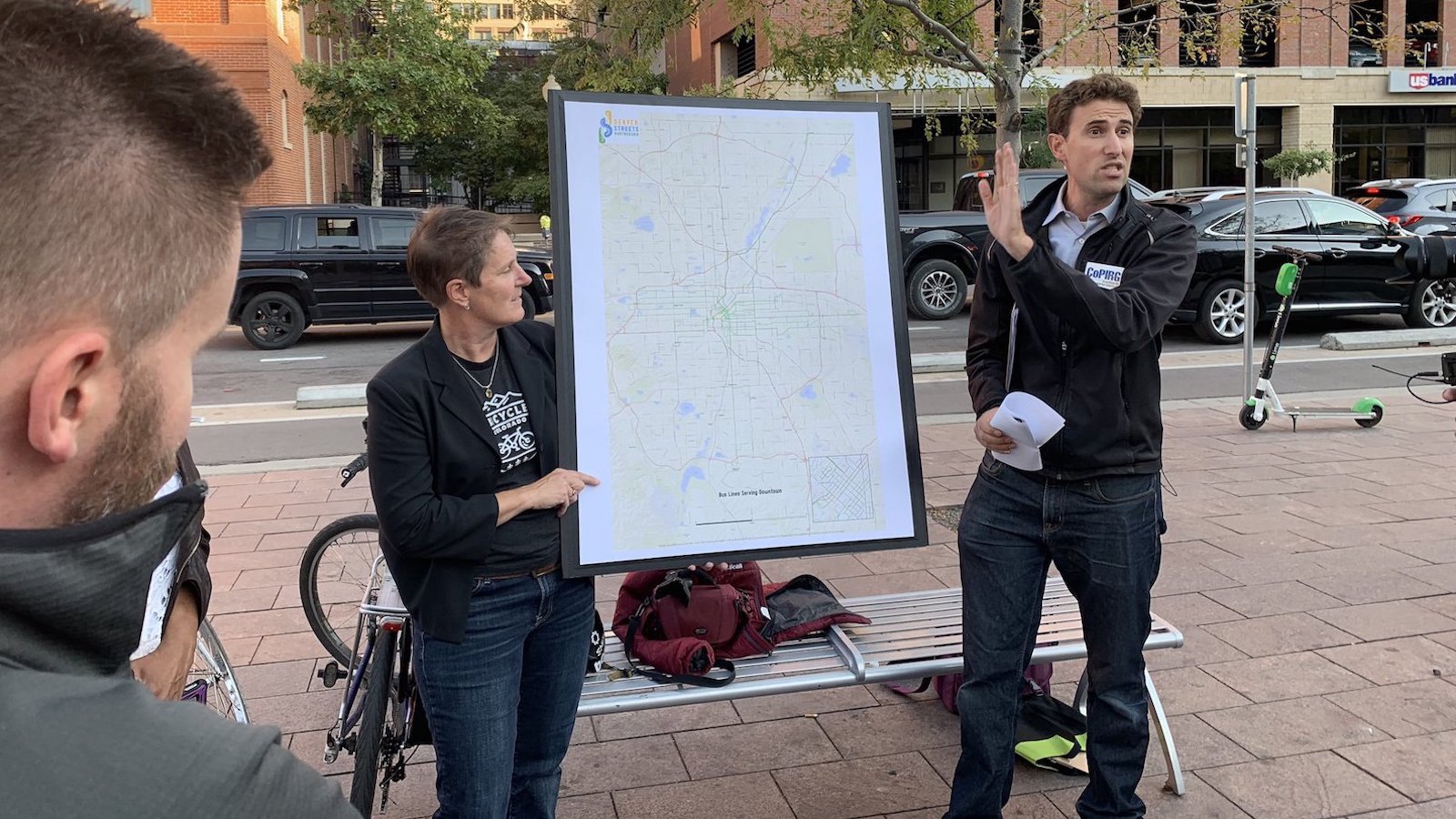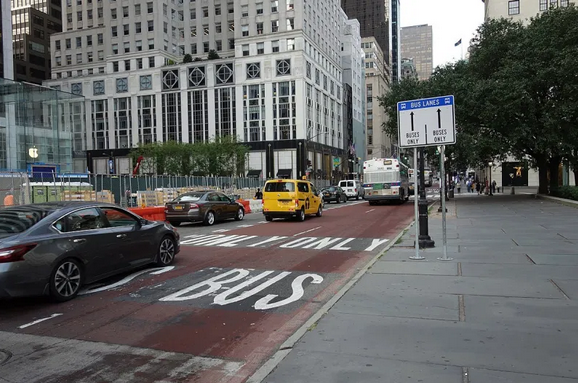a
America has a bus problem: People aren't riding them.
Despite buses’ potential for cooling the climate, cleaning up our air, and making our cities more livable, in the last three decades, U.S. bus ridership dropped off 17 percent. Reasons cited for the decline have included slow service and poor reliability, low gas prices and inexpensive auto loans, negative cultural perceptions of the bus, and the rise of ride-sharing apps.
Falling ridership is a big problem. Bloomberg CityLab outlines the vicious cycle transit agencies risk entering when passengers leave: Low ridership leads to service cuts, service cuts cause ridership to drop even further, and riders switch to private vehicles, making traffic and air pollution worse.
While factors like the allure of low gas prices may be outside a transit agency’s control, one step cities can take to help bring more people back to the bus is to improve service. And one cost-effective way to do that isn’t to change anything about the bus — it’s to reorganize the street.
Dedicated bus lanes to the rescue
The thing about dedicated bus lanes is that they’re the opposite of cool. They’re not “cutting edge.” They’re not eye-catching. They’re just lanes for buses painted on busy avenues.
But despite bus lanes’ decided lack of style, as major American cities look for ways to lower their carbon emissions, they’re looking to these low-tech, low-cost lanes to help them. Here’s the case for why more cities should get on board.

Buses are better for climate
Transportation is the largest source of global warming emissions in the United States, making up 28 percent of the country’s total output, according to the most recent EPA data. More than half of those emissions come from light-duty vehicles (passenger cars and trucks). With the average passenger vehicle emitting five tons of carbon dioxide per year, the more cities can promote the switch from private, single-occupancy vehicles to more efficient options like public transportation, the better it will be for lightening their carbon footprints.
When it comes to lowering emissions, the bus has a lot to offer.
Even with buses carrying just 28 percent capacity on average, the U.S. Department of Transportation estimated in 2010 that bus transit released 33 percent lower carbon emissions per passenger mile than the average single-occupancy vehicle. The more people who ride, the sharper the difference becomes.

To improve service, set the bus free
Nearly a year ago, an unusual group of racers joined CoPIRG Director Danny Katz to see which mode of transportation could get across roughly a mile of Denver’s business district the fastest during the 5:00 PM rush hour.
The cyclists cruised the route from Union Station to Civic Center Station in 16 minutes. Then came passengers on the city’s Mall Ride, a shuttle with dedicated lanes up and down 16th Street. Then the electric wheelchair rider. After 25 minutes came the walkers and drivers. And in last place, the riders of the beleaguered 15 bus clocked in at 48 minutes — more than triple the time it took the cyclists — having just missed an earlier bus before getting bogged down in traffic.
The racers had set out to prove a point: When buses have to compete with cars on crowded streets, they get jammed up with them, contributing to slower arrivals and less reliable service. Sectioning off a lane of the street solely for buses, even just during peak hours, can help them avoid slow-downs. New bus-only lanes installed on 15th and 17th Streets last year are now making trips faster and more reliable for Denver’s riders.

The National Association of City Transit Officials (NACTO) estimates that one 10-foot lane at peak conditions can move between 600 and 1,600 people driving in private vehicles an hour. A dedicated transit lane, on the other hand, can move between 4,000 and 8,000 people an hour.
Additionally, bus lanes can be rolled out with paint and piloted with traffic cones, which makes them comparatively inexpensive when weighed against expanding the subway or adding lanes to a highway.
Results from cities that have tried out dedicated bus lanes are promising: A bus-only lane in Arlington, Massachusetts, has cut down commute times by 10 minutes. Another running two miles across downtown Los Angeles is capable of moving 70 buses an hour during peak service times. And a busway on New York City’s 14th St. has boosted weekday ridership by 24 percent.
But the benefits of investing in public transit — be it the bus, subway or train — extend beyond just the route or line that gets developed, says NACTO. Counter to the vicious cycle started by low ridership, building up transit can spark a virtuous cycle: Making a proactive transit investment — like dedicated lanes or more stops — creates better service, which draws more riders. Capitalizing on increased demand with more transit-oriented development encourages even more people to ride, which leads to less driving.
The more people riding transit to work instead of driving themselves, the better for reducing emissions.

Doesn’t a bus lane take away space from cars?
There is a catch. Dedicating a lane for just buses can create inconveniences for drivers in the other lanes: Analysis of New York’s 14th street transit lane found increases in travel time between zero and 3.4 minutes for commuters using nearby streets.
It’s a trade-off, and one that we can’t expect will make everybody happy. Not all will agree that some inconvenience is a small price to pay for a livable climate, healthier lives and more livable communities. But many will, especially as more realize that reducing the space we dedicate to cars opens up space for so much more — enabling people to, as our campaign slogan says, drive less and live more.
There are no silver bullets
There’s a lot to recommend a tactically inserted bus lane. But they’re just a piece of the puzzle.
Much more needs to be done to scale back our transportation emissions, from replacing fossil-fuel powered vehicles (including buses!) with electric ones, to expanding light rail service, ramping up charging infrastructure, and increasing the number of people walking and biking to work each day.
Dedicated bus lanes offer cities a low-cost way to make our bus routes faster and more reliable today. Boosted ridership from better service can help us cut down on the carbon emissions heating up the planet. And, any project that can encourage a virtuous cycle of increasing ridership feeding into transit development is worth pursuing as we look for ways to lighten our carbon footprints.
Bus lanes will never be chic, it’s true. Still, they’re tools we can use right now to improve mobility and cut back on the tailpipe exhaust entering our atmosphere -- and ones we should look to more often in the race to limit the impacts of climate change.
Henry Hintermeister is a Creative Associate for the United States Public Interest Research Group. This article originally appeared on U.S. PIRG and is republished here with permission.






